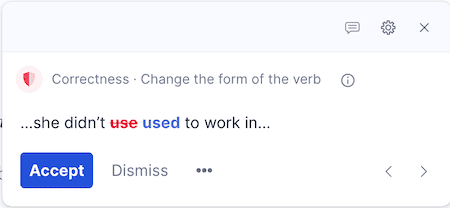
When you describe past habits or states in writing, you use the phrases use to or used to.
But which one is right? The answer is that both are correct, but it depends on grammar, as always.
The basic rule is that used to is correct in the positive form, while use to is correct in questions or negatives that use the auxiliary verb did or didn’t.
Here are three quick examples: He used to live in London. Did he use to live in Paris? No, he didn’t use to live in Paris.
Used to as a past verb
Describing states or habits in the present has no special grammatical structure other than using the present tense.
She works in Los Angeles.
She doesn’t work in New York.
However, for past habits or states that are unlikely to occur again, use to or used to followed by an infinitive verb is the most common simple past form.
She used to work in New York, but now she works in Los Angeles.
Did she use to work in London?
No, she didn’t use to work in London, but she went there on holiday many times.
The only consideration in this form is to remove the D when the auxiliary verb did or didn’t form a negative or question.
It is logical because the D on used indicates the simple past like any other verb, as does the final D in did.
It’s basic grammar that you can’t use the two past simple verbs together.
Used to as a present verb
It’s no wonder that these two little words can cause some confusion because you can also use used to in the present.
Here’s a simple example.
A hammer is used to drive nails into wood.
In this form, it uses the passive voice with an infinitive verb of purpose. It’s passive because we don’t know who uses the hammer.
Used to as an adjective
The easy way to tell if used to is an adjective is to spot the verb to be that precedes it.
As soon as you use is, am, or are, it moves used to into the present.
It means that the subject of the sentence is accustomed to or has adapted to something.
It took a while, but I’m used to speaking French now.
He says he’s used to the heat and humidity in Bangkok.
They are now used to living with the noise in the city, but it was a struggle at first.
But an important point to note is that TO is a preposition in this form. You can only follow it with a noun or a gerund (ing verb) and not an infinitive verb.
Even though the D is still there on used, it’s the first to be verb in a sentence that creates the tense.
But the D is necessary because it is the past participle that forms the adjective.
The progressive form
What about past situations or states that are continuing or developing?
Adding getting or becoming after the verb to be indicates that used to is still in progress.
He’s getting used to the heat, but it’s still tiring at work.
I’m becoming used to driving on the left, but it still feels weird.
Past Routines

An alternative to use to or used to in the past is would.
In this case, it indicates a routine action in the past, as opposed to a state or irregular occurrence.
When I was a teenager, we would go to the cinema every Friday night.
My father would take me fishing once a month.
In most cases, a time clause is necessary to indicate the regularity of a past routine, such as every week or on Sundays.
The pronunciation differences
Have you noticed that there are two ways to pronounce the word use? One sounds like a Z and the other like an S.
If it’s a verb, you pronounce it /juːz/. (Z sound)
When it’s a noun, the sound is /juːs/. (S sound)
Try saying these two sentences, and you will notice the pronunciation difference between the verb and the noun.
I use my phone all day. (Z sound)
The best use for a phone is as a camera. (S sound)
A similar difference in pronunciation occurs with used to.
He used to drive a BMW, but now he has a scooter. (S sound)
I’m used to working weekends now. (S sound)
A needle is used to sew thread. (Z sound)
In the first two sentences, the sound is S, but in the last, it’s a Z sound.
You’ll also notice a difference in the pronunciation of the link between used and to.
When we use the past simple, verbs can take a T sound, like with looked, or a D sound, like with phoned.
The verb used by itself takes the D sound in the past, but a T sound when it is in the phrase used to.
In the three examples above, the first two sentences use the T sound to join the words. But in the last, it sounds like a D.
If you are not keen on learning all the grammar rules, this is the easy way to decide what is past or present.
If the two sounds are S and T, it’s the past or the up-to-now use of use to or used to.
When it’s a Z sound, with a D, it’s the present or past of the verb use or a passive past participle.
Two tricky little words
I doubt there are many other two-word phrases as versatile as use to or used to in English.
When you dig into the grammar and pronunciation, there are lots of little nuances.
It’s rare now, but using the word pair as a pseudo-modal verb without do is possible.
It’s archaic, and you might only see it in highly formal styles of writing for negatives and questions. But perhaps Yoda would use it.
He used not to be so willing to work.
Used she to sit on the council?
You would never construct sentences like these now in modern English.
But it does show you how flexible these two words can be.
Summary
The confusion between use to or used to is because they both sound the same when we speak.
The best way to make sure you are correct in writing is to remember that you can only have one verb ending with D in the past simple tense.
If it’s a question or negative using did or didn’t, then it’s use to. In a positive sentence with no auxiliary, it’s used to.
An extra point to note is that you can’t always rely on your online grammar checker to get this right.
When I checked this text, Grammarly got it wrong a few times. Here’s one example.

That’s why it’s always better to know the rules and carefully check this grammar point yourself.
Related Reading: Blond Or Blonde? Why Do We Use These Two Different Words?



